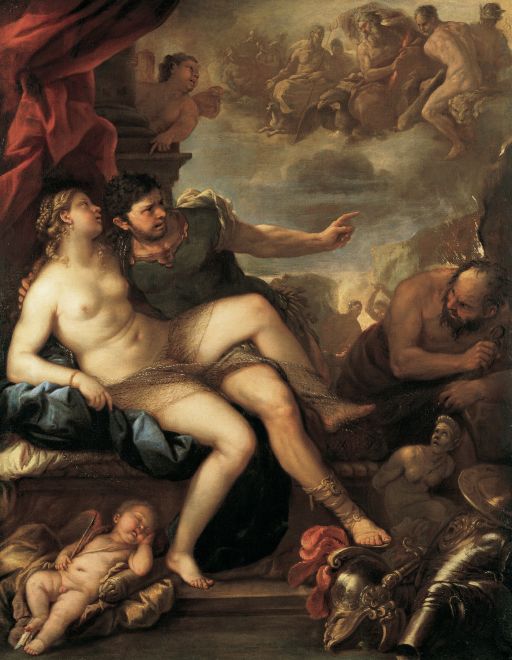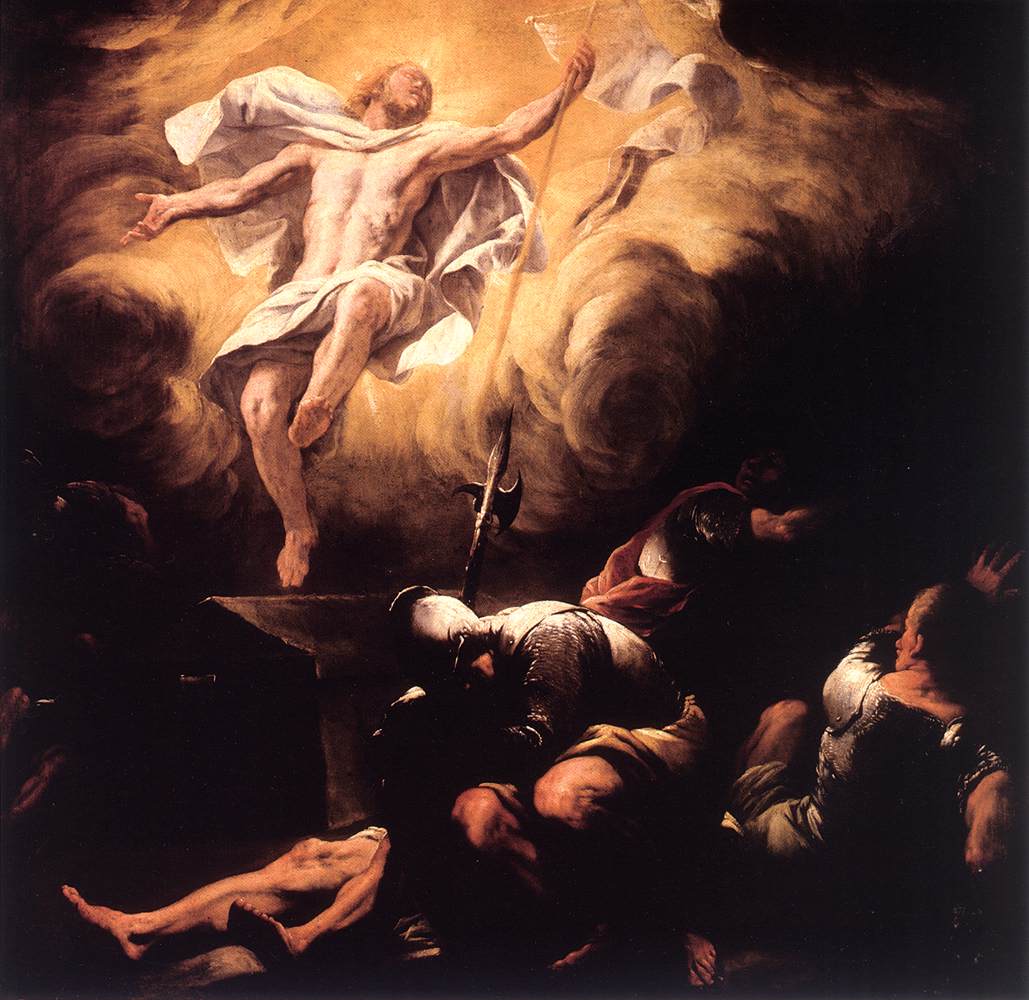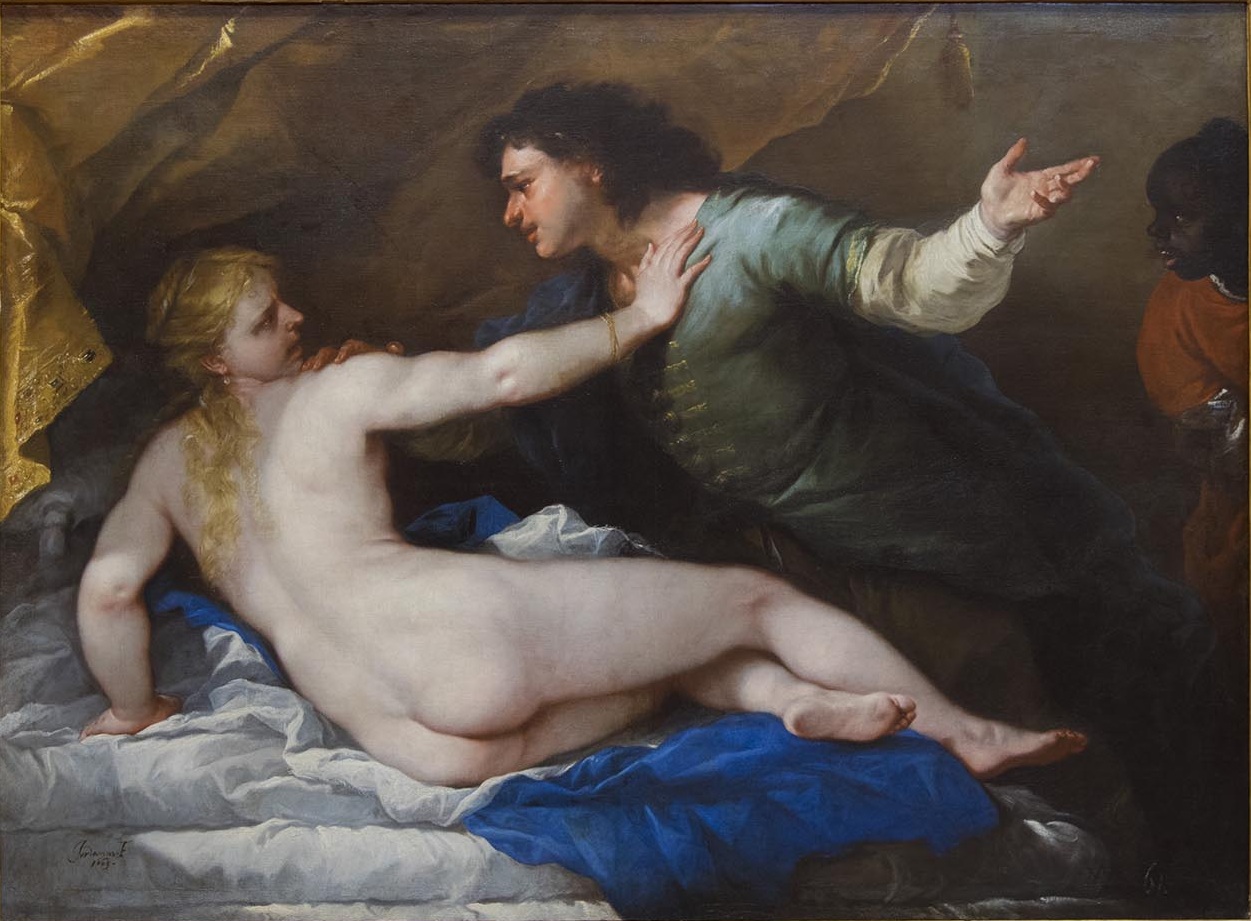Luca Giordano on:
[Wikipedia]
[Google]
[Amazon]
Luca Giordano (18 October 1634 – 3 January 1705) was an Italian late-





 Born in
Born in
and those in the Tesoro della Certosa, including the subject of ''Moses and the Brazen Serpent''; and the
File:Fa Presto - St. Michael - Google Art Project.jpg, ''St. Michael'', c. 1663,
Scholarly articles
in English about Luca Giordano both in web an
PDF
– th
Spanish Old Masters Gallery
Work of the month – Erminia and the Shepherds – Ducal House of Medinaceli Foundation
*
Jusepe de Ribera, 1591–1652
', a full text exhibition catalog from The Metropolitan Museum of Art, which includes material on Luca Giordano (see index) {{DEFAULTSORT:Giordano, Luca 1634 births 1705 deaths 17th-century Neapolitan people Italian male painters Italian printmakers Painters from Naples Italian Baroque painters Court painters 17th-century Italian painters 18th-century Italian painters 18th-century Italian male artists
Baroque
The Baroque (, ; ) is a style of architecture, music, dance, painting, sculpture, poetry, and other arts that flourished in Europe from the early 17th century until the 1750s. In the territories of the Spanish and Portuguese empires including t ...
painter and printmaker in etching
Etching is traditionally the process of using strong acid or mordant to cut into the unprotected parts of a metal surface to create a design in intaglio (incised) in the metal. In modern manufacturing, other chemicals may be used on other types ...
. Fluent and decorative, he worked successfully in Naples and Rome, Florence, and Venice, before spending a decade in Spain.
Early life and training




 Born in
Born in Naples
Naples (; it, Napoli ; nap, Napule ), from grc, Νεάπολις, Neápolis, lit=new city. is the regional capital of Campania and the third-largest city of Italy, after Rome and Milan, with a population of 909,048 within the city's adminis ...
, Giordano was the son of the painter Antonio Giordano. In around 1650 he was apprenticed to Ribera on the recommendation of the viceroy of Naples and his early work was heavily influenced by his teacher. Like Ribera, he painted many half-length figures of philosophers, either imaginary portraits of specific figures, or generic types.
He acquired the nickname ''Luca fa presto'', which translates into "Luca paints quickly." His speed, in design as well as handiwork, and his versatility, which enabled him to imitate other painters deceptively, earned for him two other epithets, "The Thunderbolt" (''Fulmine'') and "The Proteus" of painting.
Following a period studying in Rome, Parma and Venice, Giordano developed an elaborate Baroque style fusing Venetian and Roman Influences. His mature work combines the ornamental pomp of Paul Veronese
Paolo Caliari (152819 April 1588), known as Paolo Veronese ( , also , ), was an Italian Renaissance painter based in Venice, known for extremely large history paintings of religion and mythology, such as ''The Wedding at Cana'' (1563) and ''The ...
with the lively complex schemes, the "grand manner", of Pietro da Cortona
Pietro da Cortona (; 1 November 1596 or 159716 May 1669) was an Italian Baroque painter and architect. Along with his contemporaries and rivals Gian Lorenzo Bernini and Francesco Borromini, he was one of the key figures in the emergence of Roman ...
. He is also noted for his lively and showy use of colour.
Florence
In 1682–1683 Giordano painted various fresco series inFlorence
Florence ( ; it, Firenze ) is a city in Central Italy and the capital city of the Tuscany region. It is the most populated city in Tuscany, with 383,083 inhabitants in 2016, and over 1,520,000 in its metropolitan area.Bilancio demografico an ...
, including one in the dome of Corsini Chapel of the Chiesa del Carmine. In the large block occupied by the former Medici palace, he painted the ceiling of the Biblioteca Riccardiana
The Biblioteca Riccardiana (''Riccardian Library'') is a library in Florence, Italy. The library is located adjacent to the Palazzo Medici Riccardi. The main facade of Michelozzo's Medici Riccardi palace is on Via Camillo Cavour (corner of Via de ...
(''Allegory of Divine Wisdom'') and the long gallery of the Palazzo Medici-Riccardi
The Palazzo Medici, also called the Palazzo Medici Riccardi after the later family that acquired and expanded it, is a Renaissance palace located in Florence, Italy. It is the seat of the Metropolitan City of Florence and a museum.
Overview
T ...
. The vast frescoes of the latter are contained in the 1670s gallery addition, overlooking the gardens. The planning was overseen by Alessandro Segni and commissioned by Francesco Riccardi
Francesco, the Italian (and original) version of the personal name " Francis", is the most common given name among males in Italy. Notable persons with that name include:
People with the given name Francesco
* Francesco I (disambiguation), sev ...
. They include the prototypic hagiographic celebration of the Medici family in the center, surrounded by a series of interlocking narratives: allegorical figures (the ''Cardinal Virtues'', the ''Elements of Nature'') and mythological episodes (''Neptune and Amphitrita'', ''The Rape of Proserpine'', ''The Triumphal procession of Bacchus'', ''The Death of Adonis'','' Ceres'' and ''Triptolemus'').
Court painter in Spain (1692–1702)
In 1692 Giordano went to Spain at the invitation of Charles II. He stayed there for ten years, returning to Naples in 1702, following Charles' death. While in Spain, he painted major decorative schemes at theBuen Retiro Palace
Buen Retiro Palace (Spanish: ''Palacio del Buen Retiro'') in Madrid was a large palace complex designed by the architect Alonso Carbonell (c. 1590–1660) and built on the orders of Philip IV of Spain as a secondary residence and place of recrea ...
, El Escorial
El Escorial, or the Royal Site of San Lorenzo de El Escorial ( es, Monasterio y Sitio de El Escorial en Madrid), or Monasterio del Escorial (), is a historical residence of the King of Spain located in the town of San Lorenzo de El Escorial, u ...
, the sacristry of Toledo Cathedral
, native_name_lang =
, image = Toledo Cathedral, from Plaza del Ayuntamiento.jpg
, imagesize = 300px
, imagelink =
, imagealt =
, landscape =
, caption ...
, The Royal Palace of Aranjuez. ''The Allegory of the Golden Fleece'', a c. 1694 fresco
Fresco (plural ''frescos'' or ''frescoes'') is a technique of mural painting executed upon freshly laid ("wet") lime plaster. Water is used as the vehicle for the dry-powder pigment to merge with the plaster, and with the setting of the plaste ...
on the ceiling of the Casón del Buen Retiro is one of the possible reasons given for the building having survived when most of the other Buen Retiro palace complex buildings were demolished in the nineteenth century, now it's an annex of the Prado Museum Complex that holds a library for researchers. He also painted part of the frescoes at San Antonio de los Alemanes church and many pictures for the court, private patrons and churches.''Painting in Naples 1606-1705'', p.168 His pupils, Aniello Rossi
Aniello may refer to:
;Given name
* Aniello Ascione (1680–1708), Italian painter of still lifes
* Aniello Califano (1870–1919), Italian poet and writer
* Aniello Campagna (1607–1648), Roman Catholic prelate, Bishop of Nusco
* Lee Aniello Cas ...
and Matteo Pacelli
Matteo Pacelli (died 1731), born in Basilicata, was an Italian historical painter.
Biography
He studied under Luca Giordano. He traveled with Giordano to Spain
, image_flag = Bandera de España.svg
, image_coat = Escudo ...
, assisted him in Spain.
Giordano was popular at the Spanish court, and the king granted him the title of "caballero". His works can be seen all around Madrid, and The Prado houses a large compilation of his works. Not far from there, The Royal Academy of Fine Arts of San Fernando owns several of his works and in the neighboring Thyssen-Bornemisza Museum
The Thyssen-Bornemisza National Museum (in Spanish, the Museo Nacional Thyssen-Bornemisza (), named after its founder), or simply the Thyssen, is an art museum in Madrid, Spain, located near the Prado Museum on one of the city's main boulevards. I ...
there is a ''Judging of Salomon'' long term loan, belonging to Baroness Carmen Thyssen Private Collection.
Late work in Naples
After his return to Naples early in 1702, Giordano continued to paint prolifically. Executed in a lighter, less rhetorical style, these late works, prefiguring Rococo, proved influential throughout the eighteenth century, and were admired by Fragonard. He spent large sums in acts of munificence, and was particularly liberal to poorer artists. One of his maxims was that the good painter is the one whom the public like, and that the public are attracted more by colour than by design. Giordano had an astonishing facility, which often lead to an impression of superficiality of his works. He left many works in Rome, and far more in Naples. Of the latter, his ''Christ expelling the Traders from the Temple'' in the church of the Padri Girolamini, a colossal work, full of expressive "lazzaroni" or beggars from Naples; also the frescoes of the ''Triumph of Judith'' at San Martinoand those in the Tesoro della Certosa, including the subject of ''Moses and the Brazen Serpent''; and the
cupola
In architecture, a cupola () is a relatively small, most often dome-like, tall structure on top of a building. Often used to provide a lookout or to admit light and air, it usually crowns a larger roof or dome.
The word derives, via Italian, from ...
paintings in the Church of Santa Brigida. This church contains the artist's own tomb. Other notable examples are the ''Judgment of Paris'' in the Berlin Museum, and ''Christ with the Doctors in the Temple'', in the Corsini Gallery of Rome. In later years, he painted influential frescoes for the Cappella Corsini, the Palazzo Medici-Riccardi and other works.
Giordano died in Naples in 1705. Sources differ as to whether he died on 3 January or 12 January 1705.
Influence
His best pupils in painting werePaolo de Matteis
Paolo de Matteis (also known as ''Paolo de' Matteis''; 9 February 1662 – 26 January 1728) was an Italian painter.
Biography
He was born in Piano Vetrale, a hamlet of Orria, in the current Province of Salerno, and died in Naples. He trained wit ...
and Nicola Malinconico
Nicola Malinconico (16631721) was a Neapolitan painter of the late-Baroque. He is described as a follower of Luca Giordano, and painted mostly religious canvases. He painted the chapel altarpieces for the church of St Michele Arcangelo in Anacapri ...
. However, his influence, like his travels and career, were broad and prolific. For example, he is said to have influenced in Venice, Sebastiano Ricci, Giovan Battista Langetti
Giovanni Battista Langetti (1625–1676), also known as Giambattista Langetti, was an Italian late- Baroque painter. He was active in his native Genoa, then Rome, and finally for the longest period in Venice.
He first trained with Assereto, th ...
, Giovanni Coli, and Filippo Gherardi. Other pupils included Juan Antonio Boujas, Nunzio Ferraiuoli (Nunzio degli Afflitti), Ansel Fiammingo (il Franceschitto or Francesquitto), Giovanni Battista Lama, Andrea Miglionico
Andrea Miglionico (30 November 1662 - 1711) was an Italian painter of the late-Baroque period.
He was born in Miglionico in the province of Matera of Basilicata, and a pupil of Luca Giordano
Luca Giordano (18 October 1634 – 3 January 17 ...
, Giuseppe Simonelli, Andrea Vicenti, Andrea Viso, Tommaso Fasano, Tommaso Giaquinto, Domenico di Marino, Pedro de Calabria, Matteo Pacelli
Matteo Pacelli (died 1731), born in Basilicata, was an Italian historical painter.
Biography
He studied under Luca Giordano. He traveled with Giordano to Spain
, image_flag = Bandera de España.svg
, image_coat = Escudo ...
, Francisco Tramulles, Nicolo Maria Rossi
Nicola Maria Rossi, also known as Nicolò Maria (Naples, 1690 – Naples, 23 April 1758) was an Italian painter of the late-Baroque.
Biography
At the age of 15 years, he had begun studying a classic education, but after a fireworks injury damage ...
, Aniello Rossi
Aniello may refer to:
;Given name
* Aniello Ascione (1680–1708), Italian painter of still lifes
* Aniello Califano (1870–1919), Italian poet and writer
* Aniello Campagna (1607–1648), Roman Catholic prelate, Bishop of Nusco
* Lee Aniello Cas ...
, and Raimondo de Dominici.
As a young man, Giordano engraved works with considerable skill, including some of his own paintings, such as the ''Slaughter of the Priests of Baal''. He also painted much on the crystal borderings of looking-glasses, cabinets and others seen in many Italian palaces, and was, in this form of art, the master of Pietro Garofalo.
Critical reputation
Giordano has been criticized as being a prolific trader of all styles, and master of none.Michael Levey
Sir Michael Vincent Levey, LVO, FBA, FRSL (8 June 1927 – 28 December 2008) was a British art historian and was the director of the National Gallery from 1973 to 1986.
Biography
Levey was born in Wimbledon, London, and grew up in Leigh-on-S ...
remarks of him "Giordano was the ideal rococo
Rococo (, also ), less commonly Roccoco or Late Baroque, is an exceptionally ornamental and theatrical style of architecture, art and decoration which combines asymmetry, scrolling curves, gilding, white and pastel colours, sculpted moulding, ...
painter, speedy, prolific, dazzling in colour, assured in draughtsmanship, ever-talented and never touching the fringe of genius."Levey, Michael. ''Rococo to Revolution: Major Trends in Eighteenth-Century Painting'', 1985:24. He has been viewed as a proto-Tiepolo
Giovanni Battista Tiepolo ( , ; March 5, 1696 – March 27, 1770), also known as Giambattista (or Gianbattista) Tiepolo, was an Italian painter and printmaker from the Republic of Venice who painted in the Rococo style, considered an import ...
, reanimating that grand manner of Cortona in a style that would brighten with Tiepolo.
Gallery
:''See also :Paintings by Luca Giordano.''Gemäldegalerie, Berlin
The Gemäldegalerie (, ''Painting Gallery'') is an art museum in Berlin, Germany, and the museum where the main selection of paintings belonging to the Berlin State Museums (''Staatliche Museen zu Berlin'') is displayed. It was first opened in ...
File:Luca Giordano - The Fall of the Rebel Angels - Google Art Project.jpg, ''The Fall of the Rebel Angels'', c. 1666, Kunsthistorisches Museum
The Kunsthistorisches Museum ( "Museum of Art History", often referred to as the "Museum of Fine Arts") is an art museum in Vienna, Austria. Housed in its festive palatial building on the Vienna Ring Road, it is crowned with an octagonal do ...
File:The Adoration of the Magi, oil on canvas painting by Luca Giordano, called Fa Presto.jpg, ''The Adoration of the Magi''
Image:Luca Giordano 010.jpg, ''The creation of man'', 1684–1686, fresco
Fresco (plural ''frescos'' or ''frescoes'') is a technique of mural painting executed upon freshly laid ("wet") lime plaster. Water is used as the vehicle for the dry-powder pigment to merge with the plaster, and with the setting of the plaste ...
in the Palazzo Medici-Riccardi in Florence
Florence ( ; it, Firenze ) is a city in Central Italy and the capital city of the Tuscany region. It is the most populated city in Tuscany, with 383,083 inhabitants in 2016, and over 1,520,000 in its metropolitan area.Bilancio demografico an ...
File:Trionfo di Giuditta - Luca Giordano.jpg, ''Triumph of Judith'', Certosa di San Martino
The ("Charterhouse of St. Martin") is a former monastery complex, now a museum, in Naples, southern Italy. Along with Castel Sant'Elmo that stands beside it, this is the most visible landmark of the city, perched atop the Vomero hill that command ...
, Naples
Image:Luca Giordano 023.jpg, ''Triumph of the Medici in the clouds of Mount Olympus
Mount Olympus (; el, Όλυμπος, Ólympos, also , ) is the highest mountain in Greece. It is part of the Olympus massif near the Thermaic Gulf of the Aegean Sea, located in the Olympus Range on the border between Thessaly and Macedonia, be ...
'', 1684–1686, fresco in the Palazzo Medici-Riccardi
File:Luca_Giordano_-_Venus,_Cupid_and_Mars.jpg, '' Mars and Venus with Cupid'', 1663, Museo di Capodimonte, Naples
References
Additional sources
* * * ''Encyclopædia Britannica 2004 Ultimate Reference Suite'' DVD * O. Ferrari - G. Scavizzi, ''Luca Giordano'', Napoli, varie edizioni (1966, 1992, 2000) * M.Horak, ''Importanti opera di Luca Giordano a Piacenza'', in "Strenna Piacentina 2011" - Amici dell'Arte, Piacenza 2011 * G. Scavizzi - G. De Vito, ''Luca Giordano giovane 1650-1664'', Napoli, 2012 * M. Horak, ''Luca Giordano: la grande pala in Santa Teresa'', in "Panorama Musei", anno XVII, n. 1, 2012External links
*Scholarly articles
in English about Luca Giordano both in web an
– th
Spanish Old Masters Gallery
Work of the month – Erminia and the Shepherds – Ducal House of Medinaceli Foundation
*
Jusepe de Ribera, 1591–1652
', a full text exhibition catalog from The Metropolitan Museum of Art, which includes material on Luca Giordano (see index) {{DEFAULTSORT:Giordano, Luca 1634 births 1705 deaths 17th-century Neapolitan people Italian male painters Italian printmakers Painters from Naples Italian Baroque painters Court painters 17th-century Italian painters 18th-century Italian painters 18th-century Italian male artists